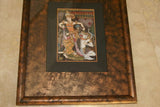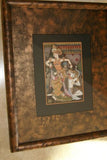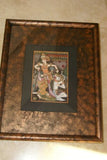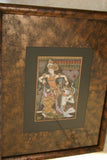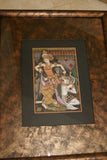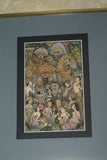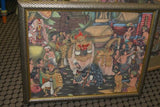TRADITIONAL BALINESE MINIATURE INK PAINTING BY KNOWN PENGOSEKAN ARTIST TOPENG MASK MONKEY DANCE UBUD ART WITH MINUTE INTENSE DETAIL PROFESSIONALLY FRAMED IN HAND PAINTED FRAME WITH 3 MATS, DFBT17 BALI ART DESIGNER DECORATOR COLLECTOR WALL DECOR
HAND-PAINTED & SIGNED BY ARTIST
INK PAINTING
MATTED AND FRAMED
MINIATURE TRADITIONAL BALINESE UBUD PAINTING FROM KNOWN ARTIST
Original authentic extremely detailed ink painting by a talented Pengosekan artist
Framed in a custom unique hand painted and signed frame with 3 mats
(one is hand painted as well to match the frame)
Item: DFBT17
Measures: 15 1/2" X 12 1/2"
(seen up to picture 9, photos 10 to 12 are of other art we have available)
This is a signed, original, authentic, extremely detailed, ink painting by a talented local Pengosekan artist that took a while to complete because of minute excruciating miniature details.
This is a rendition of the monkey dance.
Topeng which is the word “Mask” in Indonesian is a dramatic form of dance in which one or more mask wearing, ornately-costumed performers interpret traditional narratives concerning fabled kings, heroes and myths, accompanied by an orchestra of Gamelan music. It is believed that the use of masks is related to the cult of the ancestors, which considered dancers the interpreters of the gods. In this case, the masked dancer represents the monkey Anoman speaking to Princess Sinta.
In Topeng, there is a conscious attempt to include many, sometimes contradictory, aspects of the human experience: the sacred and the profane, beauty and ugliness, refinement and caricature.
The beauty and variety of Balinese paintings have gained the admiration of many scholars.
Previously, as here, the portraits of classic Hindu epics dominated the form of Balinese paintings.
Painting was understood as a form of prayer, if not to the Gods, then to the local palace, perceived as an embodiment of the holy. Artists would thus labor at the palace to demonstrate their loyalty to the king, or work at the temple to demonstrate their loyalty to the religious community.
The theme of these traditional Ubud paintings such as this one was around the Wayang, including stories of the gods and popular folk stories. Most importantly, this art was an expression of the community.
The beauty and variety of Balinese paintings have gained the admiration of many scholars.
Previously, as here, the portraits of classic Hindu epics dominated the form of Balinese paintings.
Painting was understood as a form of prayer, if not to the Gods, then to the local palace, perceived as an embodiment of the holy. Artists would thus labor at the palace to demonstrate their loyalty to the king, or work at the temple to demonstrate their loyalty to the religious community.
The theme of these traditional Ubud paintings such as this one was around the Wayang, including stories of the gods and popular folk stories. Most importantly, this art was an expression of the community.
Artists often do not sign their work, and they were always proud if their students copied their style. To have their work imitated meant they had attained the status of a Guru, the highest honor for a Balinese.
Painting is authentic and custom framed
Painting is authentic and custom framed
More on the Topeng: Topeng dance is a type of storytelling or drama dance from Indonesia accompanied with music. Dancers wear masks and bright costumes that represent characters in the play. It appeared in 15th century in Bali and Java where is prevalent still but it can also be found in other islands of Indonesia. Topeng dance originated from tribal dances held in the honor of ancestors, where dancers with masks were playing roles of messengers of gods. In the beginning, prevailing themes of Topeng dance were nature and ancestral spirits. Later themes became wider and “The Adventures of Prince Panji” became popular. After arrival of Hinduism, “Mahabharata” and “Ramayana” were adapted for performing as a Topang dance.
Topeng dance is usually performed at “odalan”- a temple anniversary celebration. It begins with appearance on the stage by characters that may not be related to the story. They all wear masks. Characters of noble background wear masks that cover the whole face and they do not talk at all. They express their characters and story only through the dance and movement. All the storytelling is done by characters of servants or jesters that wear half-masks that do not cover the mouth so they could talk. They are each telling their view of the story and lead the audience through it. Beside the main, strictly defined story, dancers include jokes and current gossips for the laughter. Mythological tales are performed side by side with common stories. Masks are the one that define a character but they are also defined by a character. Characters of noble backgrounds wear beautiful white or golden masks while a half mask of jesters is more grotesque. There are also masks of demons and animals that share common animalistic features and there are masks of gods. Strong characters have masks painted in red. Shapes of masks are defined by the local tradition. Masks in Central Java are triangular in shape, in East Java they are archaically stylized while masks in Cirebon are very stylized and have faces reduced almost to a symbol.
In the Topeng dance, the whole play is played by four to five actors that play all characters, even the female ones. One actor plays many roles in one play with different masks. An actor can have about 40 Topeng masks that are only his and it is believed that there is a special kind of bond between the actor and his mask that allows him to infuse life in it and represent a wide specter of emotions through it. It is also believed that when actors puts his mask on he is connected to the spirit realm and is in a form of trance.
The last 2 photos show additional framed authentic art we have for sale.
We also carry authentic original prints 300 years old or less in great condition, already framed or not, such as: Albin, Audubon, Baron, Barraband, Bertuch, Brodtmann, Brown, Buffon, Cassel, Curtis, Cuvier, Donovan, Edwards, Fitch, Frisch, Grandville, Harrison, Walter Hood, Latham, Linden,Linnaeus, Loddiges, Martinet, McKenney, Morris, Munting, Redoute, Reinchenbachia, Schreber, Schubert, Selby, Shaw and Nodder, Van Geel, Warner, etc.... etc...
Again, we closed our art store of antique prints and custom frames as well as our store of rare artifacts from around the world and we will now sell them here by listing them regularly. We have 1000's of antique prints and it will take a while to do so, so if you are interested in prints from the names above or others since I did not have time to list them all, please let us know.














